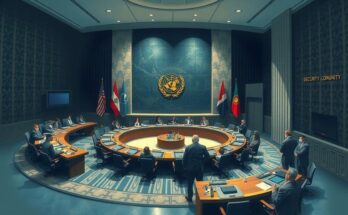Syria has sworn in a new transitional government, consisting of a 23-member Cabinet featuring diverse religious and ethnic representatives. This marks the first government under a five-year transitional period following the ousting of the Assad family. The administration, operating without a prime minister, aims to restore stability and lift economic sanctions amid ongoing humanitarian challenges as threats persist during the Eid al-Fitr holiday.
Syria has inaugurated a new transitional government, nearly four months following the removal of the Assad family from power. The new 23-member Cabinet, representing a diverse mix of religious and ethnic groups, marks the first government formed during Syria’s five-year transitional period and replaces the interim government. Notably, this administration operates under a secretary-general instead of a prime minister, consistent with the temporary constitution signed by interim President Ahmad al-Sharaa.
The newly appointed government was unveiled just before Eid al-Fitr, with some ministers retaining their prior positions, including the foreign and defence ministers. Among the new appointments is Anas Khattab, formerly the intelligence chief, now serving as the Interior Minister. Al-Sharaa, in his address, emphasized that the formation of the government signifies a collaborative effort to establish a new state, as reported by the Associate Press (AP).
Defence Minister Murhaf Abu Qasra has expressed a commitment to building a professional army that serves the people. However, the government formation notably lacks representatives from the US-backed Kurdish-led Syrian Democratic Forces (SDF) and the autonomous northeast administration. Despite this absence, al-Sharaa and SDF commander Mazloum Abdi have recently signed a ceasefire agreement aimed at integrating SDF forces into the national army.
Significant appointments also include Hind Kabawat, a Christian activist opposed to Assad, named Minister of Social Affairs and Labor, and Raed Saleh, the former head of the White Helmets, as Minister for Emergency Disasters. Other notable appointments include Mohammed Terko, a Kurdish politician as Minister of Education, and Mohammed al-Bashir, leading the interim government after Assad’s fall, as Minister of Energy, tasked with rehabilitating Syria’s energy sectors.
The new government’s primary objective is to conclude the ongoing conflict and restore peace. Recent violent clashes, primarily involving Alawite civilians, have led to significant casualties, underscoring the urgent need for stability. The inclusiveness of the government aims to demonstrate commitment to a diverse political process and potentially persuade Western nations to ease long-standing economic sanctions that have exacerbated the humanitarian crisis, leaving 90% of the Syrian population below the poverty line.
In related news, the US State Department issued a warning regarding potential threats to American citizens during the Eid al-Fitr holiday, highlighting risks of attacks on embassies and public institutions in Damascus.
The formation of Syria’s new transitional government signifies a pivotal step towards establishing a stable political framework following the removal of the Assad regime. By incorporating diverse representatives, the government seeks to foster inclusivity and appeal for lifting economic sanctions. As the nation grapples with a severe humanitarian crisis, restoring peace remains the paramount goal, particularly against a backdrop of recent violence and unrest.
Original Source: indianexpress.com




